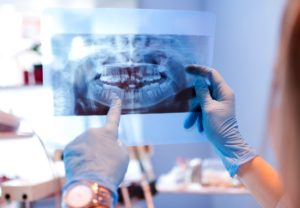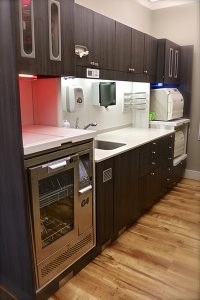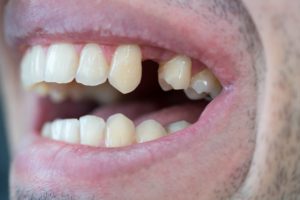Header logo
header top contact widget
Tooth Replacement
Get The Most For Your Investment When Replacing Teeth.
Posted on Jun 12, 2019 by William J. Claiborne, DDS MS
Losing a natural tooth is a big deal. Its loss not only leaves a gap in the appearance of a smile, its absence can lead to movement of surrounding teeth. 
Without all teeth in their proper positions, an open area can cause others to tilt and turn. Additionally, the one above or below will grow longer without having its ‘roommate.’ These issues can lead to broken, fractured, or chipped teeth.
Replacing a tooth involves decisions, and costs. While there are ‘cheap’ ways to replace a tooth, the ideal method – a dental implant – offers lifetime replacement that actually enhances the well-being and lifespan of surrounding teeth.
In dental implant treatment, the ‘implanted’ portion is positioned into the jaw bone as a tooth root replacement. This provides the teeth attached the same foundation as natural tooth roots have. A partial or bridge simply sits on top of gum tissues and relies on adjacent teeth for support.
When a tooth must serve as a support for ‘prosthetic’ teeth, its key role becomes greater. With the added pressure and stress to the natural tooth, there are also more risks to its structure on its own.
Because of the ability to restore the presence of natural teeth to such a great extent, dental implants are the preferred choice for replacement. Although the costs seem greater, over time, the benefits far outweigh the expense. This is why more and more adults are choosing implants to replace one, several, or all missing teeth.
However, there are many factors that can come into play when going forward with a dental implant. Your choice of doctor to place the implanted portion can greatly increase your potential to enjoy your dental implant for a lifetime.
As a Periodontist, my specialty encompasses treatment of all levels of gum disease, the re-contouring of gum tissues, and advanced training in the diagnosis and placement of dental implants. This includes the proper selection of the implant type best for each patient’s needs as well as placement at correct depths and angles.
The most troubling thing I see in implant dentistry is when a patient opted for a “good deal” with a less-experienced doctor, and having to remove a ‘failed’ implant.
Along with an intricate knowledge of the specific type of implant needed, proper placement angles and depth have much to do with the overall success of the implant. For optimal results, the doctor placing the implant should be skilled in the selection of the implant angles and positioning depths.
For example, an implant placed in the upper jaw in too-shallow bone can work its way into the sinus cavity. A lower implant in insufficient bone depth can reach a nerve that runs horizontally through the lower jaw (the mandible).
Additionally, the shape, size and the number of teeth to be attached to an implant have much to do with the type of implant system selected. When the placement doctor is only familiar with one or two types, disasters can occur.
In our Asheville periodontal office, we enjoy restoring the health and appearance of smiles. We also help patients who once struggled with dentures or partials to resume eating the foods they love again and laugh confidently in social gatherings.
The doctor is not the sole factor in success, however, Along with proper selection and placement, a patient must take measures to ensure proper oral hygiene at home. Oral bacteria can contribute to an infection that works its way into the bone surrounding the implant. In some cases, the only way to resolve the infection is to remove the implant.
When a patient entrusts their implant treatment to a skilled doctor and adheres to hygiene and healing guidelines, having an implant fail is very unlikely. The success rate of today’s implant dentistry is excellent – over 97 percent.
If you are considering dental implants, increase your potential for a successful outcome by asking a Periodontist to join your dentist in team treatment. Most general dentists have close relationships with periodontal specialists for implant placement and in treating gum disease.
Feel free to discuss your specific needs and desires before you make your decision. Call (828) 274-9440 to schedule a consultation.
Asheville Periodontic Specialty Office Offers Latest To Enhance Treatment Outcomes, Comfort.
Posted on May 13, 2019 by William J. Claiborne, DDS MS
As an Asheville NC periodontist, I know it is more than my specialized skills that keep us busy. Many dentists and other dental specialists refer patients to our office because they know each patient receives optimal care with a gentle, respectful touch.
Another thing we are known for is the state-of-the-art technology we use to save patients time while they achieve the very best results in minimal treatment time. Some of our advanced features available include:
LANAP Protocol Using PerioLase MVP-7 – An acronym for Laser-Assisted New Attachment Procedure, LANAP provides an advanced protocol to more efficiently and effectively treat periodontitis (advanced gum disease) with the PerioLase® MVP-7™ laser. This offers a minimally invasive (non-surgical) treatment alternative for patients with moderate to severe periodontal disease.LANAP treatment leaves very little discomfort and has a quick recovery time. It has also been found to stimulate bone regrowth in damaged areas.
Dental Radiology With 3-D Cone Beam Technology – We rely on 3D imaging in diagnostic and treatment planning. This latest level of 3D imaging covers the whole dentition area, giving a clear view of the mandible and maxilla (upper and lower jaw) for intricate review for the diagnostic requirements of endodontics, periodontics, orthodontics, implantology, TMJ and prosthodontics as well as dental and maxillofacial surgery.
In addition to imaging, cone beam radiographs provide images in sagittal, axial, and coronal planes. This makes it possible to locate and trace the mandibular nerve canal for pre-surgical planning for an ideal implant position.
We also like that our patients are exposed to only minute levels of radiation through a process that is fast and comfortable.
CareStream Cone Beam Computer Tomography Imaging – Our office features the Carestream 9300. This Cone Beam Computer Tomography provides dual modality panoramic and 3D imaging with exceptional detail and range. The CS 9300 can deliver 3D imaging at a significantly lower dose than 2D panoramic imaging. In fact, in a recent study, the CS 9300 and CS 9300 had up to an 85% lower radiation dose than traditional panoramic imaging.

Carestream 3600
CS 3600 intraoral scanner – No longer do our patients have impressions made with bulky, goopy trays held in their mouths!
The CS 3600 Scanner is designed to quickly and comfortably scan areas inside our patient’s mouth. It acquires digital impressions accurately and easily, scanning a full or dual arch for the fabrication of digital models or appliances.
The CS 3600 provides a highly accurate digital impression using a small, handheld scanner. It can also reach difficult–to–access areas in the patient’s mouth for superior results with improved patient comfort.
Just some of the superior features of the CS 3600 Scanner include:
• Acquires digital impressions to design crowns, inlays, onlays, bridges, orthodontic appliances and aligners, custom abutments and RPD;
• Has an Intelligent Matching System that prevents missing data in any area. Plus, it even sends a warning to indicate areas of the scan that lack detail;
• Has adaptive hole filling that automatically identifies holes and selects the appropriate anatomical color for optimal aesthetic outcomes;
• Enhances outcomes for restorations, orthodontics and implants; and,
• Displays precise, accurate HD 3D color images with vivid color and details for improved case review, analysis and communication between doctors, referrals and labs.
Simplant Dental Software for Computerized Dental Implant Placement – This advanced software system allows for pre-surgical positioning of dental implants on the computer using a 3D model of the patient’s jaw. Once the implant type is selected, a surgical template is developed that ensures a precision fit. Simplant creates optimal implant treatment success, even for complex cases. It also simplifies the team treatment process so intricate aspects of the surgical process can be discussed prior to placement.
Intraoral Camera Technology – This self-contained intraoral camera features full motion video with outstanding image quality from an internal camera that captures ideal angles and images with the click of a button. The images are sent to screen for a clear, crisp view so we can confer with patients on specific treatment issues.
Computer Imaging In Treatment Suites – Treatment suites are equipped with computers for convenient image sharing with patients. This allows patients to have a more complete understanding of their individual needs through images that can be pulled up by our dental team, with the ability to enlarge certain areas to show specific details. Through this, patients have greater involvement in treatment decisions.
Advanced Sterilization – Our custom sterilization unit is designed to adhere to or exceed established Centers For Disease Control & Prevention (CDC) guidelines for instrument processing protocols. Intuitive colored lighting identifies the receiving and cleaning of instruments.
Fully-Equipped Surgical Suites – Relax during treatment (under sedation, if desired) while you are surrounded with the serene views surrounding our Asheville periodontal office.
So you see, we are committed to providing each patient with advanced skills, experience, comfort, and technology that provides the very best in periodontal and dental implant treatment available.
If you have experienced periodontal (gum) disease or are considering gum recontouring or tooth replacement with dental implants, being referred is not always needed. Call our friendly staff to discuss your needs: 828-274-9440.
Scared? Afraid? Simple Steps To Get Past Dental Fears.
Posted on Apr 30, 2019 by William J. Claiborne, DDS MS
If you’re one of those people who have no dread of going to see a dentist, be glad. For the large percentage of adults who do experience anxiety or fear associated with dental visits, they are actually in the majority.
In the U.S., an estimated 70 percent of adults have some level of dental fear, unfortunately. About 5-10 percent of them can be categorized as “dental phobics.” These individuals have such an intense fear of dental visits that the mere thoughts of walking into an office causes reactions such as sweating or more rapid breathing.
As a periodontist, I’m a frequent witness to just how severe dental fears can be. Some people cry, some keep a white-knuckled grip on the arms of a dental chair (once they finally talk themselves into one), and some ask to be put to sleep for things as minor as dental cleanings.
 The periodontal specialty provides patients with a dental professional who has advanced training in the diagnosis and treatment of gum disease. It also covers the diagnosis and placement of dental implants, which are the “ideal” tooth replacement. In this field, I’ve seen the repercussions of both due to dental fear.
The periodontal specialty provides patients with a dental professional who has advanced training in the diagnosis and treatment of gum disease. It also covers the diagnosis and placement of dental implants, which are the “ideal” tooth replacement. In this field, I’ve seen the repercussions of both due to dental fear.
By not receiving regular dental cleanings and exams, the risks for developing gum disease rise significantly. And, since gum disease is the leading cause of adult tooth loss, it plays a key role in one’s potential to lose natural teeth.
Dental fear leads to a vicious cycle of poor oral health and tooth loss. When people are too afraid to see a dentist for regular care and fail to have small problems repaired while treatment needs (and costs) are still minimal, the process is ongoing. As gum health declines, the risks for tooth loss increases.
No one wants to end up in dentures. While TV commercials for denture adhesives or same-day denture clinics try to come across as upbeat, life wearing a denture is anything but. Long-time denture wearers struggle to bite, chew, and even speak without worrisome, uncomfortable slips or rubbing against tender gum tissues.
Too, the uncertainty of a denture can make some people uneasy when dining out or in other social settings. It’s not unusual for denture wearers to decline invitations when food is a key centerpiece of the gathering. This is sad. It is also detrimental to one’s health. Social involvement is an important part of our overall well-being.
If you are among those who avoid dental care because of uncontrollable jitters or downright “scared” feelings, below are several steps you may wish to consider to help you move past them:
• Begin by writing down what you believe caused your fears in the first place. Was it a painful procedure? Was it a rough dentist who ignored your obvious discomfort? If you know what sparked your fear in the first place and can look-it-in-the-eye in actual words, you can begin to deal with them. This may help you bring them out of the shadows and into the light where you can begin to conquer them.
• Close your eyes and imagine your life with a healthy smile — one that makes you feel good about being close to others. Imagine conversations having fresh breath and smiling with confidence. Imagine getting compliments on your smile! Think about how you may interact more confidently with others with a smile you’re proud to share.
• If you haven’t seen a dentist on a regular basis, you may need to begin with a periodontal examination. You can do an internet search (Periodontist) in your area and get to know them through their web sites. Read the doctor’s bio and become familiar with what he or she offers in terms of technology and comfort options. When a periodontist keeps current on the techniques and technology surrounding this specialty, patient comfort is typically a leading factor among these features.
• Visit the periodontist’s office after hours. Yes, go there when they are closed so you’ll feel less intimated. Sit in the parking lot and imagine where you’d park for your visit, once scheduled. Walk up to the entrance and become familiar with the look of the entryway. This way, when your appointment is made, you’ll feel more comfortable making your way in the door.
• Call the office and be comfortable sharing your concerns. Don’t feel shy about saying, “I have a lot of dental fear and would like to begin by meeting the doctor.” Most offices have these conversations with new callers more often than you realize. As mentioned prior, dental fear and anxiety are fairly common. Most offices offer an initial consultation so you can get to know the doctor before scheduling an exam. Ask about where this consult will be held. The periodontist should have a private room available for this, where it is not part of the clinical side of the practice.
• The day of your appointment, call the office and ask about anticipated waiting time for your appointment. Most offices run on-time and your wait should be less than 15 minutes. However, unforeseen emergencies do arise that may disrupt an on-time schedule. If delayed, consider rescheduling. Having a lengthy wait time may add to your anxiety and it may be best to arrange another visit.
• When you go, take a book, newspaper, or favorite magazine for your wait time. Don’t assume that the periodontist has a selection you’ll be interested in. Some people like to work a crossword or ‘Jumble’ during their brief wait here.
• When meeting the doctor or staff, know that it is important to be straight-forward about your fear level. Don’t gloss over it. Being upfront will help the doctor tailor your care to address your fears or concerns at an appropriate level.
• Ask the doctor about comfort options, including sedation. Both oral and IV sedation (twilight sleep) should be available. Feel free to ask questions about how they are administered, recovery time, and safety monitoring measures. Your safety is as important as your comfort.
• Finally, listen to your gut. Did you feel the doctor truly ‘heard’ your concerns? Did you feel the staff was attentive? Did you feel confident in the appearance of the practice? Sometimes, the most important measure of comfort is what that “little voice” inside is telling us. If you don’t feel good about moving forward, consider a consult at another periodontal office. You should leave your consult feeling positive about moving forward.
One of the most satisfying parts of my specialty is watching a once-fearful patient transform into one with a healthy, confident smile! And, the foundation of that is a relationship of trust between the doctor and the patient.
If you are ready to get past your dental fears so you can have the smile you desire, begin by calling our Asheville periodontal office and speaking with our friendly staff at: 828-274-9440. Or, start with the steps listed above and move at a pace that feels best for you.
For Dental Implants, Begin With A Specialist For Optimal Results.
Posted on Apr 10, 2019 by William J. Claiborne, DDS MS
If you are considering dental implants to replace teeth or an appliance (dentures or partials), having your treatment BEGIN WITH a Periodontist offers many advantages to achieving a successful, overall result.
 A periodontist is a dentist who specializes in the he placement of dental implants as well as the prevention, diagnosis, and treatment of periodontal disease. Periodontists are experts in the treatment of oral inflammation of the gum tissues, which make up much of the foundation for an implant.
A periodontist is a dentist who specializes in the he placement of dental implants as well as the prevention, diagnosis, and treatment of periodontal disease. Periodontists are experts in the treatment of oral inflammation of the gum tissues, which make up much of the foundation for an implant.
A periodontist is familiar with the latest techniques for diagnosing and treating periodontal disease and trained in performing cosmetic periodontal procedures. To specialize in periodontology, he or she must undergo an additional 11 years, on average, to complete the educational, clinical and specialty requirements after high school.
Essentially, a periodontist becomes a dentist and continues on in education and training to further expand his or her realm of knowledge and skills. While some general dentists offer dental implant diagnosis and placement in their dental office, having a specially-trained periodontist can help you enjoy an optimal outcome based on a unique understanding of the supporting gums, bones, and appropriate implant types and placement.
For example, a dentist who offers dental implant services may actually have completed a brief weekend course hosted by a particular implant system company. The dentist, while ‘taught’ to place the particular implant type, is essentially instructed in what the hosting company teaches as far as diagnosis and placement of their system alone.
Yet, every mouth is different. An implant designed by one company may not be appropriate for the number of implants you actually need, nor the bone structures you have, or the number of teeth being supported. There are a number of factors that must be taken into consideration for a successful result.
A periodontist uses specialized training that covers all types of implant systems to carefully select the type of implant that is most appropriate for unique needs. From this, a treatment plan will be developed for the number of implants needed and ideal positioning in regards to existing bone structures and surrounding gum tissues.
If finding the “cheapest” price for your implant is the priority in your decision, the involvement of a periodontist will probably not be less expensive than what you’ll find advertised online. You’ll find bargains that sound too good to be true (which often are).
However, your choice in dental implant treatment should factor in the risks of failure. Some people are unaware that dental implants can “fail.” While insufficient at-home care can be a contributing factor to the need for implant removal, an implant that is placed at an improper depth and angle, or one that is too big or small to support the attached restorations (replacement teeth) is also a cause.
As a Periodontist in Asheville, I’ve had to remove a number of implants that were poorly selected or placed over the years. I feel badly for these patients, knowing they have to go through the entire process again, and make the investment all over again. In our practice, we take every step to “do it right the first time” so implant selection and placement is the very best for each patient.
At Biltmore Periodontics, we offer oral sedation for added relaxation. We also have a Board Certified Anesthesiologist on our team. Dr. Brad Stone is a medical doctor providing sedation and anesthesia for optimal comfort and relaxation. Here, our patients know us for making comfort and safety high priorities. (https://www.biltmoreperiodontics.com/comprehensive-care-team/) IV sedation provides patients with a “twilight sleep” state with a quick recovery. Too, it typically erases all memory of the procedure afterwards.
It may be tempting to consider a “cheap” dental implant offer or a “one-stop clinic” for your treatment. However, your overall comfort and long-term success should be the guiding force in your decisions in tooth replacement.
Begin with a consultation appointment. Call 828-274-9440. During this time, we can discuss the implant type that may work best for you and the process involved. We will also be happy to address anticipated fees and payment options, if desired.
Dental implants, when properly chosen, placed, and cared for, are designed to last your lifetime. In the proper hands, your new smile will be an everyday joy, every day of your life!
Recent Posts
Categories
Archives
- September 2024
- August 2024
- July 2024
- June 2024
- May 2024
- April 2024
- March 2024
- February 2024
- January 2024
- December 2023
- November 2023
- October 2023
- September 2023
- August 2023
- July 2023
- June 2023
- May 2023
- April 2023
- March 2023
- February 2023
- January 2023
- December 2022
- November 2022
- October 2022
- September 2022
- August 2022
- July 2022
- June 2022
- May 2022
- April 2022
- March 2022
- February 2022
- January 2022
- December 2021
- November 2021
- October 2021
- September 2021
- August 2021
- July 2021
- June 2021
- May 2021
- April 2021
- March 2021
- February 2021
- January 2021
- December 2020
- November 2020
- October 2020
- September 2020
- August 2020
- July 2020
- June 2020
- May 2020
- April 2020
- March 2020
- February 2020
- January 2020
- December 2019
- November 2019
- October 2019
- September 2019
- August 2019
- July 2019
- June 2019
- May 2019
- April 2019
- March 2019
- February 2019
- January 2019
- December 2018
- November 2018
- October 2018
- September 2018
- August 2018
- July 2018
- June 2018
- May 2018
- April 2018
- March 2018
- February 2018
- January 2018
- December 2017
- November 2017
- October 2017
- September 2017
- August 2017
- July 2017
- June 2017
- May 2017
- April 2017
- March 2017
- February 2017
- January 2017
- December 2016
- November 2016
- October 2016
- September 2016
- August 2016
- July 2016
- June 2016
- May 2016
- April 2016
- March 2016
- February 2016
- January 2016
- December 2015
- November 2015
- October 2015
- September 2015
- August 2015
- July 2015
- June 2015
- May 2015
- April 2015
- March 2015
- February 2015
- January 2015
- December 2014
- November 2014
- October 2014
- September 2014
- August 2014
- July 2014
- June 2014
- May 2014
- April 2014
- March 2014
- February 2014
- January 2014
- December 2013
- November 2013
- October 2013
- September 2013
- August 2013
- July 2013
- June 2013
- May 2013
- April 2013
- March 2013
- February 2013
- January 2013
- December 2012
- November 2012
- October 2012
- September 2012
- August 2012
- July 2012
- June 2012


